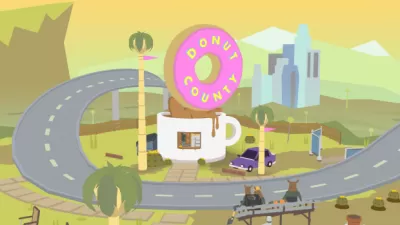In a new video game, the player is a no-good raccoon wreaking havoc on the world around him.

Ben Esposito’s new video game, Donut County, is an allegory about gentrification. A raccoon named BK lives to “meet the locals, steal their trash, and throw them in a hole.” But, as Liz Ohanesian explains, that is only until he finds himself on the other side:
When BK and his friend Mira are also swallowed by the hole, they end up at an underground campfire, confronted by those whose lives the raccoon has ruined. One by one, the displaced tell their tales as they try to make BK realize that he’s a douchebag with no regard for anything more than his own material gain.
Esposito developed the game after living in Brooklyn and then Los Angeles and realizing his own role in displacing people. He is BK, a representation of the high-income tech worker moving in and forever changing a neighborhood.
The goal of the game is to get BK to understand the consequences of taking over everything in sight along with his raccoon buddies, led by the Trash King. Ultimately, says Esposito, Donut County is about how technology and money perpetuate and magnify the gentrification of cities.
FULL STORY: This New Video Game Is an Allegory for Gentrification in L.A.

Montreal Mall to Become 6,000 Housing Units
Place Versailles will be transformed into a mixed-use complex over the next 25 years.

Planetizen Federal Action Tracker
A weekly monitor of how Trump’s orders and actions are impacting planners and planning in America.

DARTSpace Platform Streamlines Dallas TOD Application Process
The Dallas transit agency hopes a shorter permitting timeline will boost transit-oriented development around rail stations.

Study: 4% of Truckers Lack a Valid Commercial License
Over 56% of inspected trucks had other violations.

Chicago Judge Orders Thousands of Accessible Ped Signals
Only 3% of the city's crossing signals are currently accessible to blind pedestrians.

Philadelphia Swaps Car Lanes for Bikeways in Unanimous Vote
The project will transform one of the handful of streets responsible for 80% of the city’s major crashes.
Urban Design for Planners 1: Software Tools
This six-course series explores essential urban design concepts using open source software and equips planners with the tools they need to participate fully in the urban design process.
Planning for Universal Design
Learn the tools for implementing Universal Design in planning regulations.
City of Mt Shasta
City of Camden Redevelopment Agency
City of Astoria
Transportation Research & Education Center (TREC) at Portland State University
US High Speed Rail Association
City of Camden Redevelopment Agency
Municipality of Princeton (NJ)




























